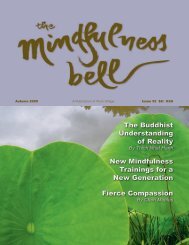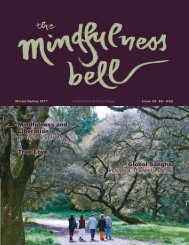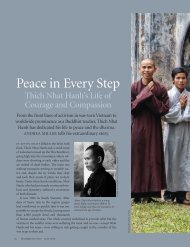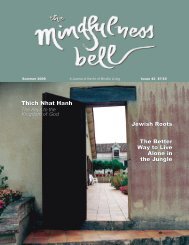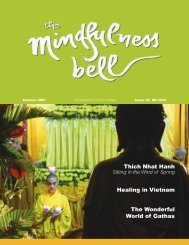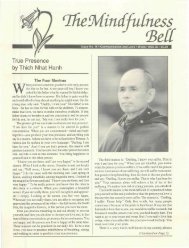Download - The Mindfulness Bell
Download - The Mindfulness Bell
Download - The Mindfulness Bell
You also want an ePaper? Increase the reach of your titles
YUMPU automatically turns print PDFs into web optimized ePapers that Google loves.
ook REVIEWS<br />
<strong>The</strong> World<br />
We Have<br />
W A Buddhist Approach to<br />
Peace and Ecology<br />
By Thich Nhat Hanh<br />
Parallax Press, 2008<br />
Soft cover, 142 pages<br />
Reviewed by<br />
Karen Hilsberg<br />
For many years, Thich Nhat Hanh has offered teachings<br />
about how we can make a future possible for ourselves<br />
and our descendants. Now people around the world have<br />
become acutely aware of the shaky ground on which we<br />
stand. Global warming, carbon emissions, soil depletion,<br />
extinction of species, deforestation, and dwindling of<br />
natural resources threaten our earth. <strong>The</strong> recent presidential<br />
election in America underscores that this is also<br />
a time of great hope and potential change. In this new<br />
book, Thich Nhat Hanh calls for a collective awakening.<br />
He offers clear instructions to help us give birth to that<br />
awakening and bring healing to ourselves, our human<br />
family, all species and Mother Earth.<br />
Thay invokes the bodhisattva Dharanimdhara, or Earth<br />
Holder, who preserves and protects the earth — the energy<br />
that holds us together as an organism. She is a kind of<br />
engineer or architect who creates space for us to live in,<br />
builds bridges and constructs roads that lead to people<br />
we love. Her task is to promote interspecies communication<br />
and to protect the environment. We can empower<br />
engaged Buddhist practices in the twenty-first century,<br />
Thich Nhat Hanh tells us, with the tools that include the<br />
Five <strong>Mindfulness</strong> Trainings, the Four Noble Truths, the<br />
Four Nutriments, and the Five Remembrances.<br />
Expanding on talks he has offered at retreats, our teacher<br />
tells us we can actually reverse the collision course on<br />
which we find ourselves. He writes, “When we begin this<br />
practice, we want things to be permanent and we think<br />
things have a separate self. Whenever things change, we<br />
suffer. To help us not to suffer, the Buddha gave us the<br />
truths of impermanence and non-self as keys. When we<br />
look at the impermanent and nonself nature of all things,<br />
we’re using those keys to open the door to reality, or nirvana.<br />
<strong>The</strong>n our fear and our suffering disappear … that is<br />
why it is very important to deal with our fear and despair<br />
before we can deal with the issue of global warming or<br />
other environmental concerns. <strong>The</strong> Buddha is very clear<br />
about this: we have to heal ourselves first before we can<br />
heal the planet.”<br />
<strong>The</strong> World We Have concludes with a section called<br />
“Practices for Mindful Living.” Here, we are offered<br />
Earth Gathas, Touching the Earth and Deep Relaxation<br />
exercises, and an Earth Peace Treaty Commitment Sheet<br />
— this can be submitted to Deer Park Monastery along<br />
with the treaties of thousands of others who have made<br />
their commitment to heal the planet. We are given the<br />
hope to simplify our lives, conserve natural resources, eat<br />
lower on the food chain. This deep and meaningful text is<br />
published in a small pocket-sized edition, and is printed<br />
by Parallax on 100% post-consumer fiber.<br />
What Book!<br />
Buddha Poems from<br />
Beat to Hiphop<br />
Edited by Gary Gach<br />
Parallax Press, 2008<br />
Softcover, 248 pages<br />
Reviewed by Judith Toy<br />
Reading Zen poetry is like turning yourself upside-down<br />
and letting all the change fall out of your pockets. Gary<br />
Gach, editor of <strong>The</strong> Idiot’s Guide to Understanding Buddhism,<br />
edited this anthology of Zen poems first issued in<br />
1998, and now reissued by Parallax Press, What Book!<br />
Buddha Poems from Beat to Hiphop.<br />
Indeed, what poems As I read these pages I smile, finding<br />
that the space around the words is the poem, or as integral<br />
as the words themselves. I feel a little like Mahakashyapa<br />
when he saw the Buddha holding a flower. From Lew<br />
Welch: “I saw myself/a ring of bone/in the clear stream/of<br />
all of it.” And from Arthur Sze: “We step outside, and the<br />
silence is as/water is, taking the shape of the container.”<br />
And from the celebrated Korean poet, Ko Un (pronounced<br />
Go Une), an answer to the classic koan, what was your<br />
face before you were born “Before you were born/before<br />
your dad/before your mom//your burbling/was there.” A<br />
burbling of the preverbal word.<br />
“A poet once located poetry as somewhere before or<br />
after words take place,” the editor writes. Thus one of<br />
the 84,000 Dharma doors is generously flung open to<br />
mindfulness, to liberation: verse — the root of which<br />
means turning.<br />
With an introduction by Peter Coyote, who writes this<br />
collection helped him understand the scale of Buddhist<br />
influence on the “popular mind,” here is a Who’s Who of<br />
143 poets of Buddhist renown and unknowns, alive and<br />
dead, beat and monastic and both. Offering verses that are<br />
keenly alive and well grouped under one cover, we hear the<br />
voices of Czeslaw Milosz, Maxine Hong Kingston, Philip<br />
Whalen, Bob Dylan, Allen Ginsberg, Chogyam Trungpa<br />
and Thich Nhat Hanh, almost as one voice. M.C. Richards<br />
the <strong>Mindfulness</strong> <strong>Bell</strong> 45



